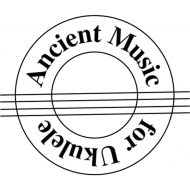Selection of Music for this Book
All the pieces in this book were written for the vihuela and voice and are from Libro V of Fuenllana’s publication Libro de música para vihuela intitulado Orphenica Lyra (Seville, 1554).
The vocal line is arranged as the first part in the music (i.e. stems up on the notes) and is based on the tab markings in the original folio being written in red while the vihuela part is written in black. The vocal melody sometimes drops below the pitch of the notes in the accompaniment. For many sonetos, the bass vocal line has been raised an octave to fit the musical range of the ukulele, which causes conflicts with the accompaniment (i.e. two notes to be played on the same string), so the two parts have been written out separately. For one of the sonetos, the both the original and raised vocal parts are presented (the bass version can be played on guitar with drop-D tuning).
Notes on the Composers and Pieces
All sources are Wikipedia.
The term sonnet is derived from the Italian word sonetto or soneto (literally “little song”, derived from the Latin word sonus, meaning a sound). By the 13th century it signified a poem of fourteen lines that followed a strict rhyme scheme and structure. During the Renaissance, the sonnet became the “choice mode of expressing romantic love.
A romance is a characteristic poem of the Spanish oral tradition. Romances reworked legends, fairy tales, and history to suit the readers’ and hearers’ tastes. They were very popular during the 15th century when compilations of romances were made in books called “romanceros”.
A madrigal is a secular vocal music composition of the Renaissance and early Baroque eras. Most madrigals are through-composed, featuring different music for each stanza of lyrics, whereby the composer expresses the emotions contained in each line and in single words of the poem being sung.
Miguel de Fuenllana (ca 1500 – 1579) was a Spanish vihuelist and composer of the Renaissance. Little is known of his life. It is assumed from his name that his roots lie in the municipality of Fuenllana, in the province of Ciudad Real, although he was born in Navalcarnero, Madrid. He was blind from birth and servied in the Spanish court to Philip II of Spain and Isabel de Valois, third wife of Philip II. He later served Don Sebastian of Portugal in Lisbon starting in 1574.
He published a Libro de música para vihuela intitulado Orphenica Lyra (Seville, 1554), known briefly as Orphenica Lyra. His style is polyphonic and he was adept at finding apt harmonies and counterpoint to popular melodies.
Orphenica Lyra constitutes the largest collection of music for vihuela (and renaissance guitar). It is made up of 188 pieces spread over six books. Of these, approximately two-thirds are arrangements of pieces or transcriptions of polyphonic vocal work by other Spanish, Flemish and Italian Renaissance composers.
Pedro Guerrero (ca 1520) was a Spanish composer of the Renaissance. He was born in Seville, probably around 1520, and he may have sung in the Seville Cathedral choir. He was singer of the powerful dukes of Medina Sidonia from 1533 to 1536.[ He was the older brother of Francisco Guerrero and taught him music prior to Francisco’s time studying with Cristobal de Morales. By 1560 he had taken a position as a singer in Santa Maria Maggiore in Rome. His surviving compositions are scant. Several sacred motets are extant, as well as about ten secular songs in Spanish, though these only survive in tabulated versions for vihuela.
Cristóbal de Morales (ca 1500 – 1553) was a Spanish composer of the Renaissance. He is generally considered to be the most influential Spanish composer before Tomás Luis de Victoria
Bernal – no information available.
Notes on the Tabulature
Italian tabulature was used by Spanish composers Mudarra, Fuenllana and others in the 16th century in music for the vihuela and Renaissance guitar. It almost looks like modern tabulation in that it uses numbers to represent the frets (zero for an open string, “1” for the first fret, “2” for the second fret, etc.) The duration of the notes are above the staff and look like our modern notes (whole notes, half notes, quarter notes), including dotted notes. Italian tabulature has the highest sounding string on the bottom line and the lowest sounding string on the top line (i.e. upside down from modern tabulation).
